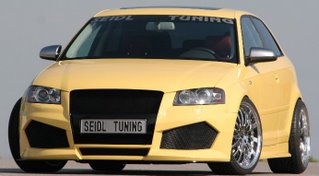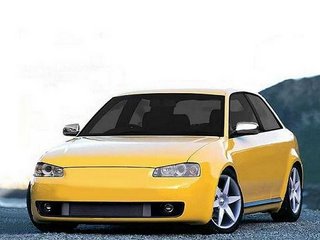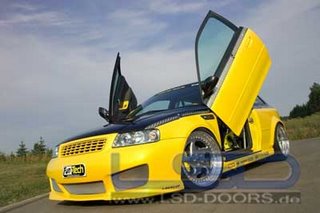




The Audi A3 is a compact near-luxury car / small family car produced by the German automaker Audi since 1996. It uses the Volkswagen A platform shared with the Volkswagen Golf, Škoda Octavia and SEAT León.
The original A3 (or Typ 8L) was introduced in the European market in 1996, marking Audi's return to the lower market segments since the demise of the Audi 50. Using the VW Golf's platform, it bears a natural close resemblance to its contemporary, the Golf Mk. IV. The car was initially available only with a three-door hatchback body, in order to present a more sporty image than the Golf, in both front- and four-wheel drive. All engines had a four-cylinder configuration and were transversally mounted. After the A4, the Audi A3 was the second model in the Audi lineup to use five valves per cylinder.
In 1999, Audi expanded the range with the introduction of an entry level model (1.6 L), a sporty version (1.8 Turbo with 180 PS (132 kW)) and a more powerful Diesel (1.9 TDI with pumpe-düse technology and variable geometry turbocharger). The four-wheel-drive A3 1.8T Quattro used either the 150 hp (110 kW) and 180 PS (132 kW) and the same Haldex-based all-wheel drive system as the Audi S3 and the original Audi TT. 1999 was also the year Audi was forced to bow to market demands and introduced a hastily conceived five-door body, that the company had never intended to produce.
In late 2000, the A3 range was revised with new light clusters, an improved interior, and the introduction of a six-speed manual gearbox, on the 180 PS 1.8 Turbo and the brand new 130 PS (96 kW) 1.9 TDI. Audi's ESP (Electronic Stability Program) traction-control and brakeforce distribution computer became standard equipment.
Although the Audi A3 was replaced in Europe during 2003, the first generation model continues to be sold in developing countries, most notably Brazil.
In the 2003 Geneva Motor Show, Audi launched the second-generation of the A3, the Typ 8P, designed by Walter de'Silva. Originally launched as a 3-door hatchback only with four cylinder engines, it featured a new mechanical platform, a redesigned and more spacious interior, new petrol engines with Fuel Stratified Injection and standard six-speed gearboxes (except on the base 1.6).
In mid 2003, the line was updated with two sports models, a 2.0 Turbo FSI version with 200 PS (147 kW) and a 3.2 VR6 engine (for the first time) with 250 PS (184 kW). Quattro four wheel drive and the S-Tronic semi-auto gearbox were introduced as optionals (quattro is standard on the V6) on every model 140 PS and over.
A new 5-door body, dubbed Sportback, was introduced in June 2004. Unlike the previous generation, the new A3 Sportback is 8 cm (3 in) longer than the base 3-door body, and includes improved rear cabin space and a larger luggage compartment (370 litres). It also received the new front grille originally introduced in the A8 W12.
In 2005, the S-Line trim level, with new sporty decorative elements, became available in certain models, and the 3-door received the same frontend as the Sportback. For the first time, the A3 became available in the American market, exclusively with the Sportback body, with the base 2.0 TFSI introduced in 2005 and the 3.2 V6 quattro following in 2006. In April 2006, the lineup was expanded with the introduction of a more powerful 2.0 TDI with 170 PS (125 kW).
In August 2006, Audi announced the arrival of the S3 version, which will become the new range topper. The 2.0 TFSI engine was uprated to 265 PS (195 kW), thanks to a higher turbo pressure of 2.2 bar, and is available with a standard 6-speed manual and Quattro. The second generation S3 is capable of accelerating to 100 km/h (62 mph) in 5.7 seconds. The springs and dampers were tuned for a harder setting, and ride height lowered in 25 mm (1 inch). 225/40 R18 tyres are standard.
The original A3 (or Typ 8L) was introduced in the European market in 1996, marking Audi's return to the lower market segments since the demise of the Audi 50. Using the VW Golf's platform, it bears a natural close resemblance to its contemporary, the Golf Mk. IV. The car was initially available only with a three-door hatchback body, in order to present a more sporty image than the Golf, in both front- and four-wheel drive. All engines had a four-cylinder configuration and were transversally mounted. After the A4, the Audi A3 was the second model in the Audi lineup to use five valves per cylinder.
In 1999, Audi expanded the range with the introduction of an entry level model (1.6 L), a sporty version (1.8 Turbo with 180 PS (132 kW)) and a more powerful Diesel (1.9 TDI with pumpe-düse technology and variable geometry turbocharger). The four-wheel-drive A3 1.8T Quattro used either the 150 hp (110 kW) and 180 PS (132 kW) and the same Haldex-based all-wheel drive system as the Audi S3 and the original Audi TT. 1999 was also the year Audi was forced to bow to market demands and introduced a hastily conceived five-door body, that the company had never intended to produce.
In late 2000, the A3 range was revised with new light clusters, an improved interior, and the introduction of a six-speed manual gearbox, on the 180 PS 1.8 Turbo and the brand new 130 PS (96 kW) 1.9 TDI. Audi's ESP (Electronic Stability Program) traction-control and brakeforce distribution computer became standard equipment.
Although the Audi A3 was replaced in Europe during 2003, the first generation model continues to be sold in developing countries, most notably Brazil.
In the 2003 Geneva Motor Show, Audi launched the second-generation of the A3, the Typ 8P, designed by Walter de'Silva. Originally launched as a 3-door hatchback only with four cylinder engines, it featured a new mechanical platform, a redesigned and more spacious interior, new petrol engines with Fuel Stratified Injection and standard six-speed gearboxes (except on the base 1.6).
In mid 2003, the line was updated with two sports models, a 2.0 Turbo FSI version with 200 PS (147 kW) and a 3.2 VR6 engine (for the first time) with 250 PS (184 kW). Quattro four wheel drive and the S-Tronic semi-auto gearbox were introduced as optionals (quattro is standard on the V6) on every model 140 PS and over.
A new 5-door body, dubbed Sportback, was introduced in June 2004. Unlike the previous generation, the new A3 Sportback is 8 cm (3 in) longer than the base 3-door body, and includes improved rear cabin space and a larger luggage compartment (370 litres). It also received the new front grille originally introduced in the A8 W12.
In 2005, the S-Line trim level, with new sporty decorative elements, became available in certain models, and the 3-door received the same frontend as the Sportback. For the first time, the A3 became available in the American market, exclusively with the Sportback body, with the base 2.0 TFSI introduced in 2005 and the 3.2 V6 quattro following in 2006. In April 2006, the lineup was expanded with the introduction of a more powerful 2.0 TDI with 170 PS (125 kW).
In August 2006, Audi announced the arrival of the S3 version, which will become the new range topper. The 2.0 TFSI engine was uprated to 265 PS (195 kW), thanks to a higher turbo pressure of 2.2 bar, and is available with a standard 6-speed manual and Quattro. The second generation S3 is capable of accelerating to 100 km/h (62 mph) in 5.7 seconds. The springs and dampers were tuned for a harder setting, and ride height lowered in 25 mm (1 inch). 225/40 R18 tyres are standard.
No comments:
Post a Comment